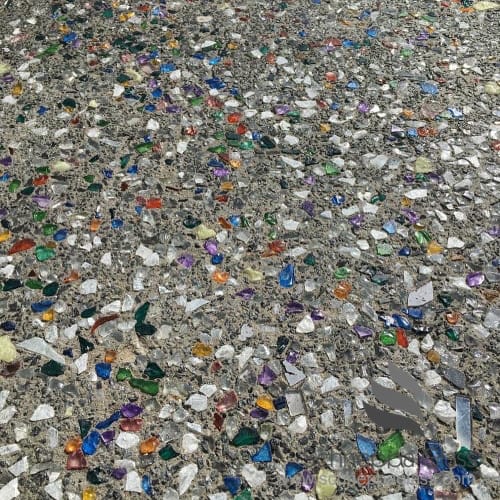I work at a winery and glass recycling has been on my mind lately. I was curious about the process to create glassphalt as a way to create a purpose for old wine bottles that would be cost effective and good for the environment. Currently, it costs more to recycle glass than it does to create new glass, and thus, there really is no good solution for the ample amount of wine bottles in our area. Hedges Winery has created a program now, but prior to that nothing was happening with glass. I wanted to ask ChatGPT what we could do to make this new product. This was its reply.
Glassphalt — also known as glassphalt concrete, glass pavement, or glasscrete — is a type of asphalt pavement that includes recycled glass. Here is a step-by-step guide on how to make glassphalt:
- Collect and prepare the glass: Collect recycled glass from local recycling centers or waste management facilities. Clean and sort the glass by color and size to ensure uniformity in the final product.
- Crush the glass: Use a glass crusher or grinder to crush the glass into small, uniform particles. The glass should be crushed to a size that resembles coarse sand or fine gravel.
- Prepare the asphalt binder: Heat asphalt binder in a heating plant or kettle to approximately 300–350° Fahrenheit until it becomes a liquid.
- Add the glass particles: Add the crushed glass particles to the hot asphalt binder in a ratio of approximately 20–30% glass to 70–80% asphalt.
- Mix the ingredients: Mix the asphalt binder and crushed glass particles thoroughly until they are evenly distributed.
- Lay the glassphalt: Use standard paving equipment to lay the glassphalt onto the road surface. The glassphalt mixture is laid and compacted in the same way as traditional asphalt.
- Allow time for curing: Allow the glassphalt to cure and harden for several hours before allowing traffic to drive on it.
With these steps, you can create a sustainable and durable glassphalt pavement that can last for years. Keep in mind that the exact process may vary depending on the specific materials and equipment used.
The asphalt binder used in glassphalt is typically made from a blend of bitumen* and other materials, such as aggregates and polymers, which help to improve the properties of the binder.
Here is a general recipe for the asphalt binder used in glassphalt:
Ingredients:
Bitumen* (60–80% by weight)Aggregate (20–30% by weight)Polymer modifier (up to 5% by weight)
Instructions:
- Heat the bitumen* in a heating plant or kettle to approximately 300–350° Fahrenheit until it becomes a liquid.
- Add the aggregate to the liquid bitumen* and mix thoroughly. The aggregate used in the binder should be similar in size to the glass particles used in the glassphalt mixture.
- Add the polymer modifier to the mixture and continue to mix until the binder is homogenous.
The asphalt binder is now ready to be mixed with the crushed glass particles to create the Glassphalt mixture.Keep in mind that this recipe is a general guideline and the exact recipe for the asphalt binder, which can vary depending on the specific requirements of the project. The use of polymer modifiers, for example, can vary depending on the climate and traffic conditions in the area where the glassphalt will be used. It is important to consult with a qualified engineer or pavement specialist to determine the appropriate recipe for your project.
* Bitumen, also known as asphalt or asphalt cement, is a sticky, black, highly viscous liquid or semi-solid form of petroleum. It is a byproduct of the refining process of crude oil, and it is one of the primary components of asphalt concrete used in road construction. Bitumen is composed mainly of hydrocarbons, such as alkanes, cycloalkanes, and aromatic hydrocarbons. It is highly resistant to water, weather, and chemical degradation, making it an ideal material for use in paving and roofing applications.
There are several natural alternatives to bitumen that can be used in road construction, although they are not as commonly used as bitumen.
- Bioasphalt: Bioasphalt is a type of asphalt made from renewable resources, such as plant oils or sugar cane molasses. It is considered to be more environmentally friendly than traditional asphalt, as it emits less carbon dioxide during production and use.
- Geosynthetics: Geosynthetics are synthetic materials used in road construction that can reduce the need for traditional asphalt binders. For example, geotextiles can be used as a separator layer between the subgrade and the asphalt pavement, while geocells can be used to reinforce the pavement structure.
- Natural resins: Some natural resins, such as pine resin, have been used as a binder in road construction. However, they are not as durable as bitumen and may require more frequent maintenance.
- Lime and cement: Lime and cement can also be used as a binder in road construction, although they are typically used in combination with other materials, such as fly ash or slag, to improve their performance.
It is important to note that each of these natural alternatives has its own set of advantages and disadvantages and may not be suitable for all types of road construction projects. It is important to consult with a qualified engineer or pavement specialist to determine the appropriate materials for your project.

